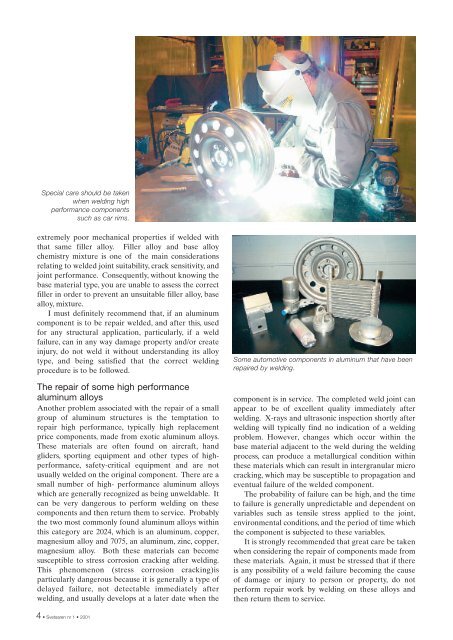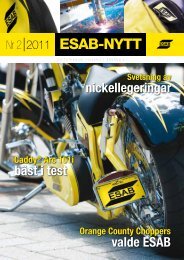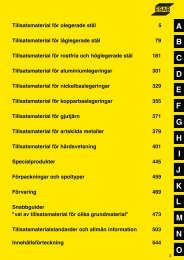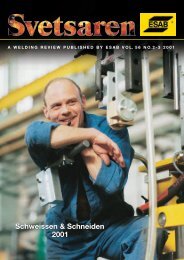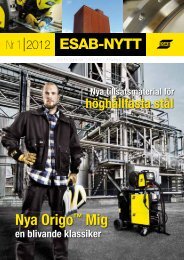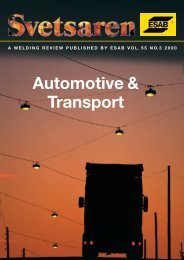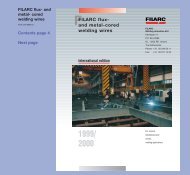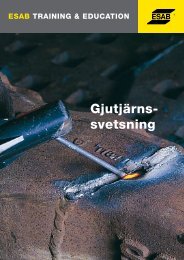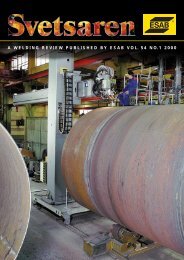Repair & Maintenance Repair & Maintenance - Esab
Repair & Maintenance Repair & Maintenance - Esab
Repair & Maintenance Repair & Maintenance - Esab
You also want an ePaper? Increase the reach of your titles
YUMPU automatically turns print PDFs into web optimized ePapers that Google loves.
Special care should be taken<br />
when welding high<br />
performance components<br />
such as car rims.<br />
extremely poor mechanical properties if welded with<br />
that same filler alloy. Filler alloy and base alloy<br />
chemistry mixture is one of the main considerations<br />
relating to welded joint suitability, crack sensitivity, and<br />
joint performance. Consequently, without knowing the<br />
base material type, you are unable to assess the correct<br />
filler in order to prevent an unsuitable filler alloy, base<br />
alloy, mixture.<br />
I must definitely recommend that, if an aluminum<br />
component is to be repair welded, and after this, used<br />
for any structural application, particularly, if a weld<br />
failure, can in any way damage property and/or create<br />
injury, do not weld it without understanding its alloy<br />
type, and being satisfied that the correct welding<br />
procedure is to be followed.<br />
The repair of some high performance<br />
aluminum alloys<br />
Another problem associated with the repair of a small<br />
group of aluminum structures is the temptation to<br />
repair high performance, typically high replacement<br />
price components, made from exotic aluminum alloys.<br />
These materials are often found on aircraft, hand<br />
gliders, sporting equipment and other types of highperformance,<br />
safety-critical equipment and are not<br />
usually welded on the original component. There are a<br />
small number of high- performance aluminum alloys<br />
which are generally recognized as being unweldable. It<br />
can be very dangerous to perform welding on these<br />
components and then return them to service. Probably<br />
the two most commonly found aluminum alloys within<br />
this category are 2024, which is an aluminum, copper,<br />
magnesium alloy and 7075, an aluminum, zinc, copper,<br />
magnesium alloy. Both these materials can become<br />
susceptible to stress corrosion cracking after welding.<br />
This phenomenon (stress corrosion cracking)is<br />
particularly dangerous because it is generally a type of<br />
delayed failure, not detectable immediately after<br />
welding, and usually develops at a later date when the<br />
Some automotive components in aluminum that have been<br />
repaired by welding.<br />
component is in service. The completed weld joint can<br />
appear to be of excellent quality immediately after<br />
welding. X-rays and ultrasonic inspection shortly after<br />
welding will typically find no indication of a welding<br />
problem. However, changes which occur within the<br />
base material adjacent to the weld during the welding<br />
process, can produce a metallurgical condition within<br />
these materials which can result in intergranular micro<br />
cracking, which may be susceptible to propagation and<br />
eventual failure of the welded component.<br />
The probability of failure can be high, and the time<br />
to failure is generally unpredictable and dependent on<br />
variables such as tensile stress applied to the joint,<br />
environmental conditions, and the period of time which<br />
the component is subjected to these variables.<br />
It is strongly recommended that great care be taken<br />
when considering the repair of components made from<br />
these materials. Again, it must be stressed that if there<br />
is any possibility of a weld failure becoming the cause<br />
of damage or injury to person or property, do not<br />
perform repair work by welding on these alloys and<br />
then return them to service.<br />
4 • Svetsaren nr 1 • 2001


